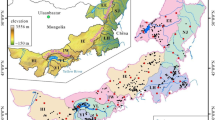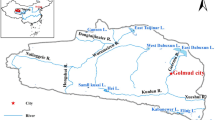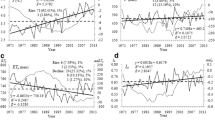Abstract
Changes in the status of freshwater resources are a topic of major global, regional and local concern. This is especially so in the arid and semi-arid regions of China, where shortage of water resources plays a crucial role in limiting sustainable socioeconomic development, as well as in sustaining natural ecosystems. Recent climate change, as well as the effects of localized human activity, such as the use of water for irrigation agriculture, may have significant effects on the status of the water resources in the region. Here, we report the results of a study of changes in the areas of lakes in Gonghe Basin, northeastern Tibetan Plateau of China, over the last 60 years. The data were acquired from optical satellite images and demonstrate that the total water area of lakes in Gonghe Basin decreased significantly from the 1950s to 1980s. The cause is ascribed mainly to human activity including exploitation of farmland, against a background of increasing population; in addition, climatic data for the region demonstrate a minor drying trend during this period as the temperature increased slightly. After the construction of several reservoirs, significant amounts of water were redistributed to promote irrigation agriculture and we conclude that this caused a significant shrinkage of the natural lakes. However, both the area of farmland and the population size remained approximately constant after 1990. We conclude that the variation of the total area of lakes during the second period was mainly controlled by climatic factors (precipitation and temperature). As the regional temperature reached a new high, the area of some of the lakes decreased sharply before finally maintaining a relatively steady state. We emphasize that anthropogenic climate change and human activity have both significantly influenced the status of water resources in the arid and semi-arid regions of China.
Similar content being viewed by others
References
Bureau of Statistics of Qinghai. 2014. Qinghai Statistical Yearbook 2014. Beijing: China Statistics Press. (in Chinese)
Chen F H, Yu Z C, Yang M L, et al. 2008. Holocene moisture evolution in arid central Asia and its out-of-phase relationship with Asian monsoon history. Quaternary Science Reviews, 27(3–4): 351–364.
Chen F H, Zhang J W, Cheng B, et al. 2012. Late Quaternary high lake levels and environmental changes since last deglacial in Dalianhai, Gonghe Basin in Qinghai province. Quaternary Sciences, 32(1): 122–131. (in Chinese)
Chen J, Li G J, Yang J D, et al. 2007. Nd and Sr isotopic characteristics of Chinese deserts: Implications for the provenances of Asian dust. Geochimica et Cosmochimica Acta, 71(15): 3904–3914.
Cheng B, Chen F H, Zhang J W. 2013. Palaeovegetational and palaeoenvironmental changes since the last deglacial in Gonghe Basin, northeast Tibetan Plateau. Journal of Geographical Sciences, 23(1): 136–146.
Cretaux J F, Letolle R, Bergé-Nguyen M. 2013. History of Aral Sea level variability and current scientific debates. Global and Planetary Change, 110(Part A): 99–113.
Editorial Committee of Overview of Hainan Tibetan Autonomous Prefecture. 2009. Overview of Hainan Tibetan Autonomous Prefecture. Beijing: The Ethnic Publishing House, 56. (in Chinese)
Ding Y J, Liu S Y, Ye B S, et al. 2006. Climatic implications on variations of lakes in the cold and arid regions of China during the recent 50 years. Journal of Glaciology and Geocryology, 28(5): 623–632. (in Chinese)
Immerzeel W, van Beek L P H, Bierkens M F P. 2010. Climate change will affect the Asian water towers. Science, 328(5984): 1382–1385.
Intergovernmental Panel on Climate Change (IPCC). 2013. Climate change 2013: the physical science basis. In: Stocker T F, Qin D, Plattner G K, et al. Contribution of Working Group I to the Fifth Assessment Report of the Intergovernmental Panel on Climate Change. Cambridge, United Kingdom: Cambridge University Press.
Lei Y B, Yao T D, Bird B W, et al. 2013. Coherent lake growth on the central Tibetan Plateau since the 1970s: Characterization and attribution. Journal of Hydrology, 483: 61–67.
Lei Y B, Yang K, Wang B, et al. 2014. Response of inland lake dynamics over the Tibetan Plateau to climate change. Climatic Change, 125(2): 281–290.
Li L, Shi X H, Shen H Y, et al. 2011. Cause of water level fluctuation in Qinghai Lake from 1960 to 2009 and its future trend forecasting. Journal of Natural Resources, 26(9): 1566–1574. (in Chinese)
Liu B K, Wei X L, Du Y E, et al. 2013. Dynamics of Qinghai Lake area based on environmental mitigation satellite data. Pratacultural Science, 30(2): 178–184. (in Chinese)
Liu X X, Wen Z H, Shu L C, et al. 2014. Analysis of surface area changes of Keluke and Tuosu lakes over past 40 years and influencing factors. Water Resources Protection, 30(1): 28–33, 63. (in Chinese)
Lu A X, Yao T D, Wang L H, et al. 2005. Study on the fluctuations of typical glaciers and lakes in the Tibetan Plateau using remote sensing. Journal of Glaciology and Geocryology, 27(6): 783–792. (in Chinese)
Ma R H, Yang G S, Duan H T, et al. 2011. China’s lakes at present: Number, area and spatial distribution. Science China Earth Sciences, 54(2): 283–289.
Mason I M, Guzkowska M A J, Rapley C G, et al. 1994. The response of lake levels and areas to climatic change. Climate Change, 27(2): 161–197.
Oki T, Kanae S. 2006. Global hydrological cycles and world water resources. Science, 313(5790): 1068–1072.
Phan V H, Lindenbergh R, Menenti M. 2012. ICESat derived elevation changes of Tibetan lakes between 2003 and 2009. International Journal of Applied Earth Observation and Geoinformation, 17: 12–22.
Phan V H, Lindenbergh R C, Menenti M. 2013. Geometric dependency of Tibetan lakes on glacial runoff. Hydrology and Earth System Sciences, 17(10): 4061–4077.
Pullen A, Kapp P, McCallister A T, et al. 2011. Qaidam Basin and northern Tibetan Plateau as dust sources for the Chinese Loess Plateau and paleoclimatic implications. Geology, 39(11): 1031–1034.
Qiang M R, Song L, Chen F H, et al. 2013. A 16-ka lake-level record inferred from macrofossils in a sediment core from Genggahai Lake, northeastern Qinghai-Tibetan Plateau (China). Journal Paleolimnology, 49(4): 575–590.
Qiu X F, Zeng Y, Miao Q L. 2001. Sand-dust storms in China: temporal-spatial distribution and tracks of source lands. Journal of Geographical Sciences, 11(3): 253–260.
Qu Y G. 1994. Water balance and forecasting of water level change in Qinghai Lake. Journal of Lake Sciences, 6(4): 298–307. (in Chinese)
Shen F, Kuang D B. 2003. Remote sensing investigation and survey of Qinghai Lake in the past 25 years. Journal of Lake Sciences, 15(4): 289–296. (in Chinese)
Sherwood S, Fu Q. 2014. A drier future? Science, 343(6172): 737–739.
Shi M Y, Guo L X, Yang H W, et al. 1990. The discussion about dry trend of lakes Yingdehai, Genggahai and Dalianhai in Gonghe Basin. Journal of Desert Research, 10(4): 51–55. (in Chinese)
Shi Y F, Shen Y P, Kang E S, et al. 2007. Recent and future climate change in northwest China. Climatic Change, 80(3–4): 379–393.
Song C Q, Huang B, Ke L H. 2013. Modeling and analysis of lake water storage changes on the Tibetan Plateau using multi-mission satellite data. Remote Sensing of Environment, 135: 25–35.
Song C Q, Huang B, Ke L H, et al. 2014a. Remote sensing of alpine lake water environment changes on the Tibetan Plateau and surroundings: A review. ISPRS Journal of Photogrammetry and Remote Sensing, 92: 26–37.
Song C Q, Huang B, Ke L H. 2014b. Inter-annual changes of alpine inland lake water storage on the Tibetan Plateau: Detection and analysis by integrating satellite altimetry and optical imagery. Hydrological Processes, 28(4): 2411–2418.
Song C Q, Huang B, Ke L H, et al. 2014c. Seasonal and abrupt changes in the water level of closed lakes on the Tibetan Plateau and implications for climate impacts. Journal of Hydrology, 514: 131–144.
Song C Q, Huang B, Richards K S, et al. 2014d. Accelerated lake expansion on the Tibetan Plateau in the 2000s: Induced by glacial melting or other processes? Water Resources Resesrch, 50(4): 3170–3186.
Sun Q F, Colin C. 2014. Paleoclimate and paleoenvironment of Gonghe Basin, Qinghai-Tibet Plateau, during the lastdeglacial: Weathering, erosion and vegetation cover affect clay mineral formation. Acta Geologica Sinica (English Edition), 88(2): 647–660.
Wang X W, Gong P, Zhao Y Y, et al. 2013. Water-level changes in China's large lakes determined from ICESat/GLAS data. Remote Sensing of Environment, 132: 131–144.
Yang K, Wu H, Qin J, et al. 2014. Recent climate changes over the Tibetan Plateau and their impacts on energy and water cycle: A review. Global and Planetary Change, 112: 79–91.
Zhang G Q, Xie H J, Duan S Q, et al. 2011a. Water level variation of Lake Qinghai from satellite and in situ measurements under climate change. Journal of Applied Remote Sensing, 5(1): 053532, doi:10.1117/1.3601363.
Zhang G Q, Xie H J, Kang S C, et al. 2011b. Monitoring lake level changes on the Tibetan Plateau using ICESat altimetry data (2003-2009). Remote Sensing of Environment, 115(7): 1733–1742.
Zhang G Q, Yao T D, Xie H J, et al. 2013a. Increased mass over the Tibetan Plateau: From lakes or glaciers? Geophysical Research Letters, 40(10): 2125–2130.
Zhang G Q, Xie H J, Yao T D, et al. 2013b. Water balance estimates of ten greatest lakes in China using ICESat and Landsat data. Chinese Science Bulletin, 58(31): 3815–3829.
Zhang G Q, Xie H J, Yao T D, et al. 2014. Quantitative water resources assessment of Qinghai Lake basin using Snowmelt Runoff Model (SRM). Journal of Hydrology, 519(Part A): 976–987.
Zhang J. 1991. Annals of Gonghe County. Xining: Qinghai People’s Press. (in Chinese)
Zhao X B, Geng Z C. 2004. Reason of Dalian Lake dried up in Gonghe Basin. Science and Technology of Qinghai Agriculture and Forestry, (1): 19–20. (in Chinese)
Zhou H H, Li W H, Chen Y N, et al. 2014. Water-salt succession patterns (1951–2011) and its response to climate change in Lake Bosten. Journal of Lake Sciences, 26(1): 55–65. (in Chinese)
Zhou S Q, Kang S C, Chen F, et al. 2013. Water balance observations reveal significant subsurface water seepage from Lake Nam Co, south-central Tibetan Plateau. Journal of Hydrology, 491: 89–99.
Author information
Authors and Affiliations
Corresponding author
Rights and permissions
About this article
Cite this article
Wu, D., Chen, F., Li, K. et al. Effects of climate change and human activity on lake shrinkage in Gonghe Basin of northeastern Tibetan Plateau during the past 60 years. J. Arid Land 8, 479–491 (2016). https://doi.org/10.1007/s40333-016-0125-5
Received:
Revised:
Accepted:
Published:
Issue Date:
DOI: https://doi.org/10.1007/s40333-016-0125-5




